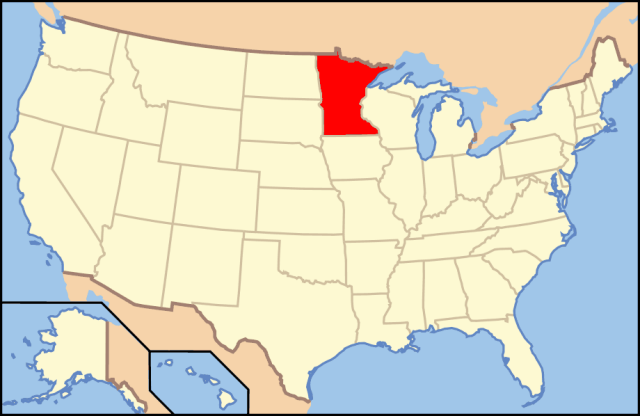The State of Minnesota
AT A GLANCE
Name: Minnesota is from Sioux words that mean “sky-tinted water.”
Nicknames: North Star State, Gopher State
Capital: St. Paul
Size: 84,397 sq. mi. (218,587 sq km)
Population: 5,489,594 (2015 est)
Statehood: Minnesota became the 32nd state on May 11, 1858.
Electoral votes: 10 (2016)
U.S. representatives: 8 (until 2016)
State tree: red pine
State flower: pink and white lady's slipper
State bird: common loon
Highest point: Eagle Mountain, 2,301 ft. (701 m)

THE PLACE
Minnesota is one of several large agricultural states in the Midwest. Lake Superior forms part of Minnesota's eastern border. Less than 20,000 years ago, large glaciers covered the land. These glaciers flattened much of the terrain into low, rolling hills. In many places, the glaciers left behind rich soil. Depressions in the ground left by the glaciers became marshes, lakes, and swamps. These lakes cover more than 20 percent of the state.
About 35 percent of Minnesota's land is forested with trees such as balsam fir, pine, spruce, and white birch. Minnesota has valuable deposits of granite, iron ore, and manganese, which is an important element in making steel.
Winters are cold and snowy, especially in the northeastern part of the state, which can receive up to 70 inches of snowfall a year. Summers are generally warm.
Facts and Firsts
- Because of its numerous lakes, Minnesota has 90,000 miles of shoreline—more than California, Florida, and Hawaii combined.
- Many popular consumer items originated in Minnesota, including the stapler, masking tape and Scotch tape, Wheaties cereal, and the Green Giant brand of vegetables.
- Frank C. Mars introduced the Milky Way candy bar in Minneapolis in 1923.
- The Hormel Company of Austin created SPAM, a meat product, in 1937. A SPAM museum in Austin features a towering wall of SPAM, built of 3,390 cans, in its lobby.
- In 1980, Scott and Brennan Olson, two Minnesota students, designed the first set of Rollerblades, skates with inline wheels instead of a blade. They created Rollerblades so they could practice hockey all year round.
- The world-famous Mayo Clinic, located in Rochester, is a leader in medical treatment.
- The Mall of America, located in Bloomington, is the largest retail space in the country. It is larger than 78 football fields and has more visitors every year than Walt Disney World, Graceland, and the Grand Canyon combined.
THE PAST
The first Europeans to explore Minnesota were French fur traders. When they arrived in the 1600s, they found Minnesota settled by Sioux and Chippewa.
The French continued to trade valuable animal furs in Minnesota even after France lost control of the area to Spain. The region was under Spanish, British, and French rule at different times. Minnesota finally became part of the United States in 1803 through the Louisiana Purchase, a land purchase from France that more than doubled the size of the United States.
Lumber became an important industry, and lumberjacks came to Minnesota to take advantage of the state's thick forests. When the government signed a treaty with the Sioux and took over their lands in 1851, settlers began to pour into the region and establish farms. In 1858, Minnesota became the nation's 32nd state.
During the Civil War, Minnesota was the first state to offer troops for the Union army. After the war's end, railroads across the state were completed, and mills that produced huge amounts of flour were built throughout Minnesota's farmland. In the 1870s, settlers from Europe, especially the Scandinavian countries of Norway, Sweden, and Finland, arrived in the state.
In the 1880s, iron ore was discovered, and Minnesota quickly became a mining center. The production of grain, lumber, and minerals for the U.S. military during both World War I and World War II supported the state's economy through the middle of the 20th century.
By the 1950s, Minnesota's best deposits of iron ore had been greatly depleted, and worldwide demand for the ore had dropped. Minnesota companies began to develop aerospace equipment, chemicals, computers, electronic equipment, and heavy machinery. The state became more urban as many residents moved from farms to the cities, and Minnesota strengthened its role as a trade and finance center for the Midwest. In the 1980s, Minnesota began to explore ways to both protect its environment and continue to develop its mineral resources.
THE PRESENT
Today, Minnesota's cities are important centers of trade, business, and manufacturing. Duluth, located on Lake Superior, is the busiest freshwater port in the nation. Minnesota's Twin Cities, St. Paul and Minneapolis, are home to several large computer companies as well as some of the nation's largest banks and insurance firms.
Agriculture remains part of Minnesota's economy. More than half of the state is farmland, and Minnesota is one of the leading producers of dairy products. The state also produces corn, hogs, soybeans, and wheat. Manufacturing associated with agriculture is also an important source of Minnesota's income; throughout the state, many dairy-processing and meat-packing plants thrive, as well as flour mills and grain producers. The mining of iron ore in the state's northern region, although it has changed over the last century, continues to round out Minnesota's economy.
Born in Minnesota
- William O. Douglas, jurist
- Bob Dylan, singer and composer
- F. Scott Fitzgerald, author
- Judy Garland, singer and actress
- J. Paul Getty, oil executive
- Cass Gilbert, architect
- Hubert H. Humphrey, U.S. senator and vice president
- Jessica Lange, actress
- Sinclair Lewis, author
- Roger Maris, baseball player
- Charles H. Mayo, surgeon
- Eugene J. McCarthy, senator
- Kate Millett, feminist
- Walter F. Mondale, U.S. vice president
- Jane Russell, actress
- Charles M. Schulz, cartoonist